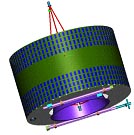The Joint Mission - Double Star
The Joint Mission
As its name suggests, Double Star will involve two satellites - each designed, developed, launched and operated by the CNSA - flying in complementary orbits around the Earth.
Each cylindrical satellite has a mass of 280 kg and generates electrical power from solar cells which are exposed to sunlight as the spacecraft spins on its axis. Both will be launched by upgraded, three-stage Long March 2C rockets, but different launch sites will be used.

Double Star |
Double Star Spacecraft (launch configuration) Characteristics
|
First to go was the "equatorial" spacecraft (TC-1), which was launched from the southern launch centre at Xichang on 29 December. This spacecraft will investigate the Earth's huge magnetic tail (magnetotail), the region where electrically charged particles (mainly ions and electrons) are accelerated towards the planet's magnetic poles by a process known as reconnection. Its nominal lifetime is 18 months.
The "polar" satellite (TC-2), which will be launched from Taiyuan, south west of Beijing, will concentrate on physical processes taking place over the magnetic poles and the development of aurorae (Northern and Southern Lights). It will follow a 700 x 39,000 km polar orbit with a period of 12 hours. TC-2 is expected to operate for at least one year.
The positions and orbits of the Double Star and Cluster spacecraft have been carefully orchestrated so that they perform a synchronised dance around the planet. While the Cluster quartet follow elongated orbits that carry them about one third of the distance to the Moon, Double Star will fly much closer to Earth, following very different paths.
By studying the Earth's magnetosphere from different perspectives, the six spacecraft will enable scientists to obtain simultaneous data on the changing magnetic field and populations of electrified particles in different regions of near-Earth space.
- Removed a total of (1) align=center.
- Removed a total of (1) border attribute.
- Removed a total of (1) cellpadding attribute.
- Removed a total of (1) cellspacing attribute.








































 Sign in
Sign in
 Science & Technology
Science & Technology